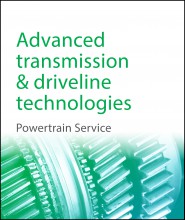
Advanced transmission & driveline technologies
There has been tremendous development in the field of automotive transmissions over the past two decades, some of which include an increased speed number, expanded ratio spread, and improved efficiency and actuation quality. Electrification of automotive transmissions is the current strategy among various suppliers as a response to stringent legislation on emissions and fuel economy. Conventional automotive transmissions for internal combustion engines are generally classified into MT, AMT, AT, DCT, and CVT. The complexity of a mechanical system is generally lower than that of conventional multispeed transmissions. However, there has been progress in AT, DCT, and CVT, largely owing to the development of transmission technology. They are gradually replacing MT and AMT in light vehicles. A huge increase in the adoption rate of HEVs and PHEVs is estimated in the next decade. The transmissions in these vehicles include electromechanical coupling systems to attain different driving modes, such as series, parallel, and power-split modes. With inclusion of a hybrid module, electrification of conventional AT, DCT, and CVT has been made possible with add-on solutions, which helps in modular design and manufacture of the new components. DHTs are the latest type of transmission and are specifically developed for HEVs and PHEVs. On the other hand, in EVs, single-speed gearboxes are the most common today. It is not necessary for EVs to be mated to a complex multispeed transmission owing to the torque and efficiency characteristics of the EM. However, a two- or three-speed transmission is found to have benefit in reducing the size of the EM. Furthermore, improvement in efficiency and reduction in weight can be achieved with a complete integration of the EM with power electronics.
There has been tremendous development in the field of automotive transmissions over the past two decades, some of which include an increased speed number, expanded ratio spread, and improved efficiency and actuation quality. Electrification of automotive transmissions is the current strategy among various suppliers as a response to stringent legislation on emissions and fuel economy. Conventional automotive transmissions for internal combustion engines are generally classified into MT, AMT, AT, DCT, and CVT. The complexity of a mechanical system is generally lower than that of conventional multispeed transmissions. However, there has been progress in AT, DCT, and CVT, largely owing to the development of transmission technology. They are gradually replacing MT and AMT in light vehicles. A huge increase in the adoption rate of HEVs and PHEVs is estimated in the next decade. The transmissions in these vehicles include electromechanical coupling systems to attain different driving modes, such as series, parallel, and power-split modes. With inclusion of a hybrid module, electrification of conventional AT, DCT, and CVT has been made possible with add-on solutions, which helps in modular design and manufacture of the new components. DHTs are the latest type of transmission and are specifically developed for HEVs and PHEVs. On the other hand, in EVs, single-speed gearboxes are the most common today. It is not necessary for EVs to be mated to a complex multispeed transmission owing to the torque and efficiency characteristics of the EM. However, a two- or three-speed transmission is found to have benefit in reducing the size of the EM. Furthermore, improvement in efficiency and reduction in weight can be achieved with a complete integration of the EM with power electronics.
From key trends affecting today’s business environment to forward-looking forecasts of future output, AutoTechInsight provides the information you need to develop strategy for each of its services.
Staying abreast of automotive sector/topic-specific developments, trends, and competitive activity can be time-consuming. With many sources available, it is often difficult to find critical and reliable market information that stakeholders of the automotive industry need. Conducting business analysis, product, or market strategy assessments without validated market data is risky.
AutoTechInsight provides the ability to access the wealth of recognized thought leadership, data, and analysis from IHS Automotive on a broad spectrum of industry topics and sectors. AutoTechInsight offers a lens into more than a dozen vehicle component categories. Each service provides the insight you need to anticipate future demand, access competitive intelligence, and stay abreast of changing dynamics.
Services coverage include:
|
|





